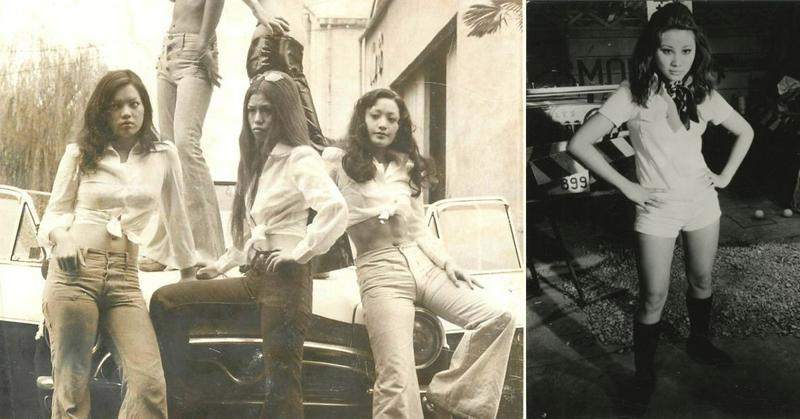The True Story Of Sukeban: Violent Girl Gangs Of '70s Japan
By | July 16, 2019

Violent schoolgirls on the loose, ruthless brawlers in cute outfits, teens with concealed razor blades -- the young female street-gangsters known as sukeban are the most interesting and sensational subculture of post-war Japan. Sukeban caught the public's fascination, becoming not just an obsession of news reports but also fodder for a wave of lurid films -- and the sukeban character type is still an ingredient of comics and animation (manga and anime) today.
If you don't think you've ever seen a sukeban character -- remember Gogo Yubari, the chain-slinging, sword-swinging schoolgirl from Quentin Tarantino's Kill Bill Vol. I (2003)? Sukeban.
And don't be misled by the movie posters and stills in this article. The sukeban -- like the pimps and drug dealers who inspired characters in Blaxploitation films of the same era -- were real. Authentic sukeban photos (that aren't actually movie stills) are rare. We're indebted to the blogger jailhouse41.tumblr.com for preserving and sourcing these amazing movie poster and press photo scans.
The Rise Of Gangs In Japan

Following Japan's defeat by the Allies in World War II, the country was occupied by U.S. and British troops between 1945 and 1952. The national morale was low, and the population was plagued by alcohol and drug abuse. This environment gave rise to groups of delinquent boys who were closely related to organized crime.
When the male gangs refused to accept female members, the sukeban emerged in the ‘60s and remained a cultural force throughout the ‘70s. The term sukeban literally translates as “girl-boss.” They were a defiant movement, pushing back against expected female behavior and stereotypes, and espousing extreme violence. Originally, the term sukeban only referred to the leader of the gang, but eventually it came to be applied to any member of the gang and by 1972, the public began to call any girl street-gang members sukeban.
They Were Distinguished By Their Fashion

The sukeban were easily distinguished by their initial uniform. They did not embrace the leather biker look of the Hell's Angels and other American gangs, but rather turned their restrictive school-girl uniforms into a symbol of their rebellion. They wore a long pleated skirt, in defiance of the mini-skirt which had risen in popularity in the ‘60s during the sexual revolution. The skirt was topped by a sailor-blouse and an untied necktie under the collar. Though their skirts were long, they often cut their shirts to expose a their midriffs. They wore Converse sneakers as well, and their clothes often had handmade modifications, including badges and buttons. They wore very little make-up and sported super-thin eyebrows.
And They Were Distinguished By Their Concealed Weapons

In the 1980s, the police produced pamphlets, describing these “omens of downfall” with their dyed or permed hair, long skirts, rolled up sleeves and colored socks. Their clothing served a purpose beyond defiance of their patriarchal culture: it was used to conceal weapons. The sukeban used their clothing to hide chains, razor blades, and bamboo swords.
The girls were from working class families and were aware that they would probably never rise out of their social situations. The sukeban provided them with the things that most gangs provide: a sense of belonging. It also allowed them to rebel against gender norms and traditional expectations for feminine behavior, and it empowered them -- though violence and petty crime aren't ideal forms of empowerment.
Criminals With Their Own Justice Code

They engaged in petty crime and the gangs brawled with each other, but adhered to a strict code of justice. The gangs were hierarchical, akin to organized crime, and had a system of punishments for breaking the rules. This system, called “lynching,” involved several levels of punishment. For example, if a girl was disloyal, did drugs, or stole someone else’s boyfriend, cigarette burns were minor punishment.
While for the most part, they engaged in petty crimes, some of them were engaged in extreme violence. The most terrifying was a group of about 50 who were led by K-Ko the Razor. The girls carried razors wrapped in cloth and tucked between their breasts. They could whip out the razor and cut their enemy’s face.
The Sukeban Were Widespread

This was not an isolated movement. Overall membership of sukeban gangs reached into the tens of thousands. They ranged in size from approximately 80 in Tokyo’s United Shoplifter’s Group up to 20,000 in Kanto Women’s Delinquent Alliance.
The Cultural Impact Of The Sukeban

The sukeban inspired films, most notably films produced by Toei Company, such as Lynch Law Classroom and Girl Boss Guerilla. Stars included the duo of Miki Sugimoto and Reiko Ike, as well as former beauty queen Reiko Oshida, and the director who essentially created the genre was Norifumi Suzuki. Without a doubt, the films gave an exaggerated portrayal of sukeban, elevating them from street hoods to antiheroes wielding samurai swords. The sukeban has also become a trope popular in manga comics and anime TV and movies.
